and the distribution of digital products.
State of IoTeX Q3 2024
- Launched in Q3’24, the IoTeX 2.0 upgrade provides decentralized infrastructure, public goods, and governance tools to support the full lifecycle of DePIN projects.
- Activity on the IoTeX Network surged after the launch of the ioID protocol that turns hardware devices into onchain entities with verifiable identity. In Q3’24, active wallets and transactions grew by 13% and 8% QoQ, respectively.
- As of Q3’24, the IoTeX Network was secured by 112 delegates actively staking $172 million, up 17% QoQ. The average staking participation reached 41.3% in Q3’24.
- The upgraded tokenomic design of IoTeX 2.0 aims to balance inflationary staking rewards with deflationary token burns and to drive the utility of the IOTX token.
- Throughout Q3’24, IoTeX integrated with the following several networks and protocols, including: Solana, TON, The Graph, Polygon, NEAR, and Injective.
IoTeX (IOTX) is a modular infrastructure platform that supports developers of decentralized physical infrastructure networks (DePIN). The IoTeX Network combines its EVM-compatible Layer-1 blockchain, offchain compute mid-layer, and open hardware to connect smart devices and real-world data to blockchains. The real-world data is sourced from smart devices, machines and sensors, and decentralized applications (dApps) across the physical and digital world.
The IoTeX Layer-1 utilizes a Randomized Delegated Proof-of-Stake (Roll-DPoS) consensus mechanism. Anyone can stake the network’s native token (IOTX) and cast a vote for one or more community-voted delegates, who manage consensus on behalf of the IoTeX Network.
IoTeX's middleware solution W3bstream is set for mainnet launch in Q1’25, providing verifiability and scalability for DePINs. W3bstream is an open infrastructure for verifiable data streaming and processing using zero-knowledge proofs and a general-purpose zkVM. W3bstream also powers the DePINscan platform — a DePIN sector-wide, map-based explorer-as-a-service — that tracks more than 280 DePIN projects.
The newly released IoTeX 2.0 upgrade aims to support the full lifecycle of DePIN projects by providing decentralized infrastructure for DePINs, public goods, and governance tools. As part of the IoTeX 2.0, the ioID protocol aims to manage the decentralized identity lifecycle in DePINs by turning hardware devices (e.g., smart devices, machines, and sensors) into onchain entities with verifiable identity. Simultaneously, the upgraded tokenomic design of IoTeX 2.0 aims to balance inflationary staking rewards with deflationary token burns and to drive the utility of the IOTX token.
Website / X (Twitter) / Discord
Key Metrics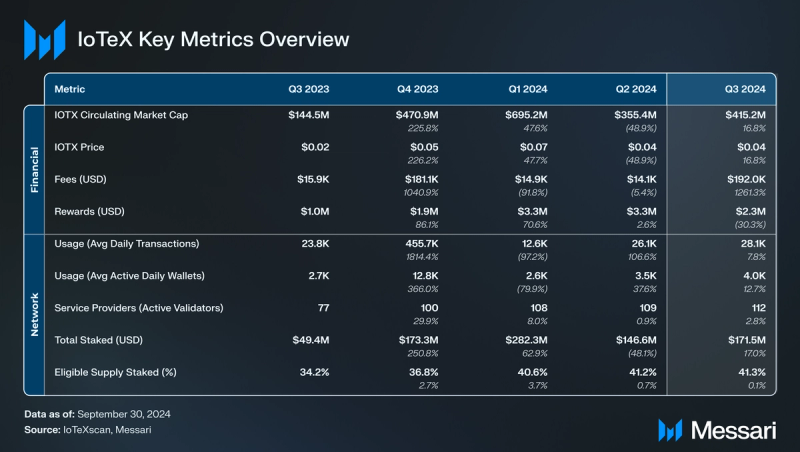 Performance AnalysisNetwork Overview
Performance AnalysisNetwork OverviewThe IoTeX Network connects supply and demand as follows:
- Supply: IoTeX provides DePIN-focused blockspace and an ecosystem to DePIN projects and other dApps. The newly released IoTeX 2.0 upgrade supports the full lifecycle of projects by providing infrastructure, public goods, and governance tools.
- Demand: Consumers of blockspace are primarily DePIN projects, but also projects in the DeFi and GameFi sectors.
Demand for the IoTeX Layer-1 blockspace from more than 100 dApps in need of data streaming and offchain compute capabilities. The real-world data is sourced from smart devices, machines and sensors, and decentralized applications (dApps).
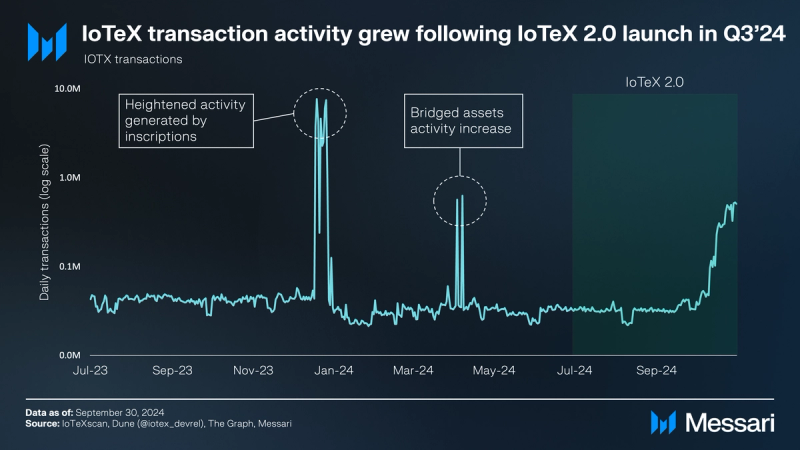
Daily active wallets on the IoTeX Network grew 13% QoQ in Q3’24 to nearly 4,000. While the metric previously spiked during the inscriptions mania in Q4’23, the recent increase may be attributed to the launch of the ioID infrastructure protocol as part of the IoTeX 2.0 launch in Q3’24.
As part of the IoTeX 2.0 launch, the ioID protocol aims to manage the decentralized identity lifecycle in DePIN. The ioID protocol is IoTeX’s onchain identity solution to issue Decentralized Identities (DID) and Verifiable Credentials (VC) to physical hardware. In simple terms, ioID turns hardware devices (e.g., smart devices, machines, and sensors) into onchain entities with verifiable identity.
As of October 2024, 5,000 ioID identities have been registered and verified onchain by nearly 500 device owners. To bootstrap DePIN networks, miners and community members can reserve ioIDs. As of the end of Q3’24, there are over 7,000 reserved ioID identities.
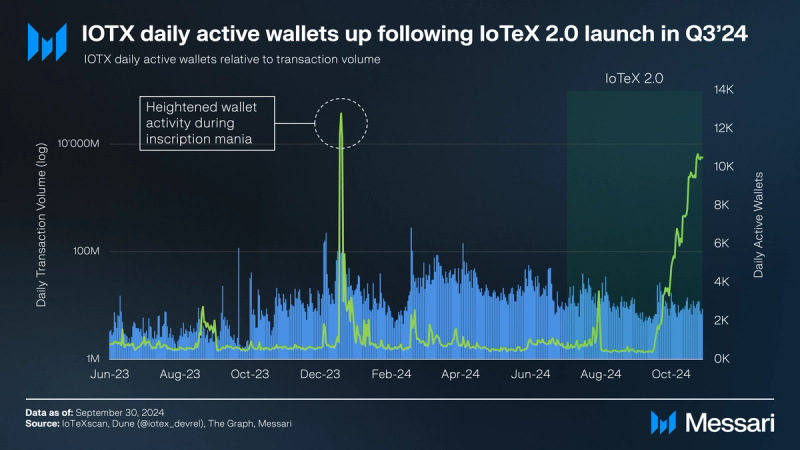
Following the launch of IoTeX 2.0 and the onboarding of new ioIDs, activity on the IoTeX Network surged 8% QoQ in terms of daily transactions, with an average of 75 transactions per second throughout Q3’24. Previously, transaction activity on the IoTeX Network surged over 1,800% QoQ in Q4’23, driven by the inscription mania one year ago.
Staking OverviewStaking represents a core component of decentralized governance on the IoTeX Network. Holders of the native IoTeX token — IOTX — deposit the token to support network operations, consensus, and governance. If token holders stake their IOTX tokens, they can vote for delegates to manage consensus on their behalf.
Tokenholders earn IOTX rewards in return for staking. Simultaneously, IoTeX 2.0 introduced inflationary staking rewards to boost the amount of IOTX staked and increase network security. While the inflation rate is decided by the community, the IOTX token is burned based on the amount of network activity.
For example, with the introduction of the ioID protocol, the IOTX token can further be utilized for ioID creation and management. Device owners are able to burn and stake IOTX to obtain ioIDs and register their hardware to the IoTeX Network. Additionally, tokenholders can restake their IOTX to earn additional rewards along with the base staking rewards.

As of Q3’24, the IoTeX Network was secured by 112 active delegates staking $172 million, up 17% QoQ. The average staking participation reached an all-time high of 41.3% in Q3’24, up from 34.2% in Q3’23.
Financial OverviewFees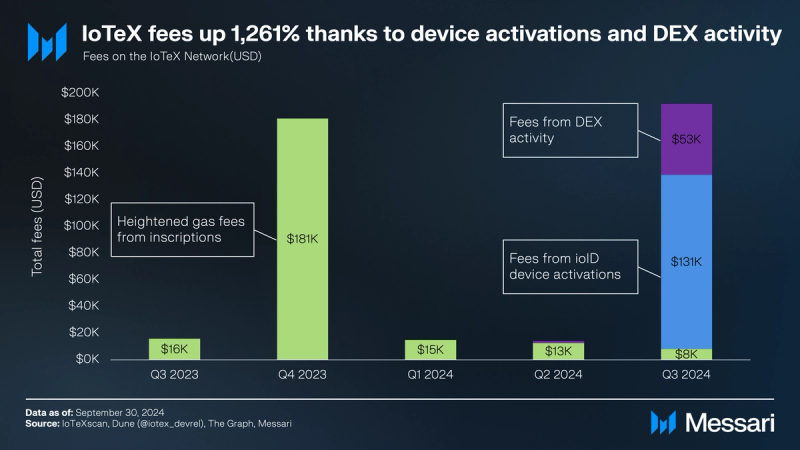
Total fees accrued by the protocol capture the demand side of the IoTeX Network:
- Gas fees: paid in IOTX by anyone initiating a transaction on the IoTeX Network, similar to Ethereum's transaction fee structure.
- Activation fees: paid upon activating an ioID device.
- DEX fees: paid in IOTX when using the mimo decentralized exchange (DEX) as part of the DePIN Liquidity Hub program.
Total fees accrued on the IoTeX Network grew by 1,261% QoQ to $192,000 in Q3’24. This growth has been fueled by the accrual of ioID device activation fees ($131,000) and by the mimo DEX fees ($53,000). With the expected activity growth on the IoTeX Layer-1 following the launch of IoTeX 2.0, total fees are set to increase further in the coming quarters.
RewardsTo deploy and maintain a community-contributed infrastructure network, IoTeX leverages token incentives. Rewards are paid to validators on the IoTeX Network from new token issuance.
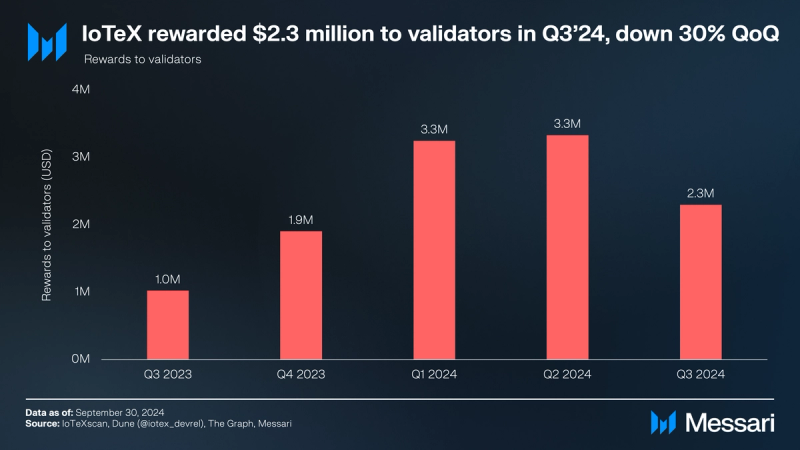
In Q3’24, rewards to validators decreased 30% QoQ to $2.3 million. In IOTX terms, rewards stayed relatively flat, up 1% QoQ from 60 million IOTX in Q2’24 to 60.6 million IOTX in Q3’24.
Ecosystem OverviewAs of the end of Q3’24, the IoTeX ecosystem has over 230 dApps, including over 50 DePIN projects. Messari’s recent DePIN sector report indicates that IoTeX is the third-largest DePIN ecosystem after Ethereum and Solana. DePIN projects building on IoTeX utilize DePIN Infrastructure Modules (DIMs) such as ioID and W3bstream or choose the IoTeX Layer-1 for their token launches. DePIN use cases include connected smart vehicles, geo-mapping, energy data tracking, health platforms, and proof-of-presence and proof-of-humanity apps. Besides DePIN, use cases on the IoTeX ecosystem include DeFi, GameFi, and NFTs.
DePINThroughout Q3’24, IoTeX has continued to provide hands-on support to its ecosystem through the DePIN Surf Accelerator and IoTeX Ecosystem Fund, including several DePIN projects:
- Network3, an AI-powered DePIN for data transmission and compute, launched a local LLM for running AI on smart devices and sold out of its V1 node sale in minutes.
- Nubila, an environmental data DePIN for ESG data collection and analysis, launched a device pre-sale for their Marco weather station.
- Wayru, a WiFi connectivity DePIN, has sold out of its Genesis hotspot device with node operators and launched the pre-sale for its next-generation WiFi miners.
- Inferix, a decentralized GPU network that focuses on AI inference, opened its public node sale, bootstrapping new supply using DePIN.
- Qualoo, a DePIN network that maps internet quality in real-time, delivering insights to both users and internet providers globally.
- PowerPod, a renewable energy DePIN focused on electric vehicle charging, has onboarded over 2,750 devices in four countries for the shared EV charging network.
Other popular projects building on the IoTeX network include uniIOTX (liquid staking), mimo (decentralized exchange), and Drop Wireless (communications infrastructure protocol).
DeFiThe DePIN Liquidity Hub program offers liquidity pool matching of up to $10,000 on mimo, a DePIN-focused decentralized exchange (DEX). By the end of Q3’24, total liquidity in the DePIN Liquidity Hub reached nearly $13 million from a total of over 600 token pairs, out of which 16 were DePIN-specific token pairs. The mimo app allows DePIN tokens from other Layer-1 networks (such as GEODNET, Streamr, WiFi Map) to be bridged to IoTeX with boosted incentives for liquidity providers.
In addition to the activity on mimo, several DeFi protocols started on the IoTeX ecosystem:
- Bedrock: a multi-asset liquid restaking protocol supports IOTX staking, generating approximately $19 million TVL on IoTeX from nearly 450 million IOTX restaked.
- Magma: a non-custodial liquid staking protocol, where users can collateralize assets including IOTX and USDC to create WEN, a 1:1 dollar-pegged stablecoin. Magma has received support from OKX Wallet and Gate Wallet.
- Loxodrome: a decentralized perpetuals exchange on IoTeX went live in August offering IOTX trading with up to 50x leverage.
The IoTeX team introduced the IoTeX 2.0 upgrade to evolve into an open decentralized physical infrastructure network (DePIN). The upgrade is designed to enable a broad range of ecosystem participants, from established decentralized applications and traditional companies to small innovative teams.
IoTeX 2.0 also introduced a modular DePIN infrastructure that allows projects to build their tech stacks from a variety of modular offerings. These modules include offchain scaling, zero-knowledge proofs, and artificial intelligence. The five key architectural components are:
- DePIN dApps: building on top of the IoTeX platform,
- DePIN Infrastructure Modules (DIMs): pre-built, interoperable components of the DePIN tech stack (such as ioID and W3bstream) that can be built by third-party teams,
- Modular Security Pool (MSP): a trusted layer secured by the IOTX token and other assets, ensuring the security and trust of the network,
- IoTeX Layer-1, and
- Users.
Simultaneously, IoTeX 2.0’s upgraded tokenomics design balances inflationary staking rewards with deflationary burning mechanisms. The goal is to maintain a stable token supply while driving the utility of the IOTX token. This new tokenomic model also introduces the Marshall DAO, a decentralized autonomous organization that allocates incentives to grow the IoTeX ecosystem through funding DePIN projects and initiatives.
The IoTeX 2.0 upgrade aims to support the full lifecycle of DePIN projects by providing infrastructure, public goods funding, and governance tools for decentralized infrastructure.
V2.0 and V1.14 SeriesThe IoTeX blockchain underwent the V2.0.0 hard fork in July. All node operators are advised to upgrade to the latest release before the arrival of the activation block and are only required to restart their nodes with the new image. This hard fork includes the following features:
- Introduces a new NFT staking contract.
- Allows users with native staking buckets to migrate to NFT-based staking.
- Wraps transactions sent in the web3js API/format in a general container format, improving execution and compatibility across various tools.
- Bug fixes and performance improvements, including automatically purging failed transactions from the action pool and handling errors within the EVM module.
Previously, the V1.14 hard fork arrived in April and added the following features:
- IIP-24: Raise the block gas limit to 50 million IOTX to enhance transaction processing capabilities.
- IIP-25: Delegate endorsement, introducing a new governance model allowing stakeholder endorsements for delegates, aiming to improve network participation and ecosystem diversity.
The complete list of changes can be found in the release notes.
Integrations with IoTeX 2.0Throughout Q3’24, IoTeX integrated with the following several networks and protocols:
- Solana cross-chain bridge to aggregate liquidity between the two DePIN ecosystems; this positions IoTeX multichain launchpad for Solana DePINs.
- Telegram partnership to bring DePIN to Telegram’s users by co-building DePIN infrastructure for the TON ecosystem.
- Irys integration to enable data integrity for DePIN builders.
- The Graph integration with IoTeX 2.0 as the Indexing module.
- Polygon integration of its AggLayer with IoTeX 2.0 for cross-chain DePIN liquidity.
- Espresso Systems integration with IoTeX 2.0 using Espresso as the sequencer module.
- Phala Network integration with IoTeX 2.0 using Phala as the verifiable compute module.
- NEAR integration with IoTeX 2.0 as the data availability (DA) module.
- Injective integration for the transfer of IoTeX assets into the Injective ecosystem.
- Coin98 integration for the transfer of tokens using Coin98 Super Wallet.
In Aug. 2024, the IoTeX community approved IIP-30, adopting the bridged USDC standard from Circle. This decision will transition the existing ioUSDC stablecoin to USDC.e. The implementation involves deploying USDC.e and its wrapper contract on IoTeX, alongside updates to IoTube validators to support the new bridge. DeFi protocols within the ecosystem will also be encouraged to adopt USDC.e.
CommunityIoTeX Improvement Proposals (IIPs) are the mechanism for proposing community-driven changes to the IoTeX protocol, processes, or ecosystem.
Transfer Delegate Ownership (IIP 28)This successful proposal aims to introduce a "Transfer Delegate Ownership" feature. This feature will allow delegate owners to change their profile addresses and offer "increased flexibility and security to delegate owners."
Marshall DAOIn conjunction with the launch of IoTeX 2.0 and its tokenomics design, IoTeX announced the Marshall DAO. The DAO will manage a pool of IOTX tokens that will be used to fund DePIN projects and initiatives. The community will be able to propose projects, and those who have IOTX staked (veIOTX) will be able to vote on projects to fund.
ioTube Support for BTC (IIP 29)This successful proposal aims to develop a bridge to facilitate the transfer of Bitcoin assets to the IoTeX network to enhance the network’s value interoperability. The proposed solution utilizes a multi-signature wallet managed by offchain witnesses to secure assets on the Bitcoin network.
Bridge Solana to IoTeX via ioTube (IIP 31)This successful proposal aims to integrate Solana with the ioTube bridge. The integration will require onchain contracts for sending/receiving assets, the ioTube Message Protocol, and offchain witness consensus.
Deprecate io1 Address Format (IIP 40)This proposal aims to deprecate the native io1 address format and utilize only Ethereum’s 0x format across the IoTeX ecosystem and tools.
DePIN AssociationThe DePIN Association was formed by IoTeX, Powerledger, POKT Network, Acurast, DePINHub, U2U Network, Impossible Cloud Network, SafeJunction, peaq, and Geodnet. The Association aims to foster the development and growth of the DePIN ecosystem by establishing DePIN industry standards and best practices, promoting collaboration, advocating for policies/regulations, and supporting research and development initiatives.
Closing SummaryLaunched in Q3’24, the IoTeX 2.0 upgrade provides decentralized infrastructure, public goods, and governance tools to support the full lifecycle of DePIN projects.
Activity on the IoTeX Network surged after the launch of the ioID protocol that turns hardware devices into onchain entities with verifiable identity. In Q3’24, both active wallets and transactions were up 13% and 8% QoQ, respectively. As of Q3’24, the IoTeX Network was secured by 112 delegates actively staking $172 million, up 17% QoQ. The average staking participation reached 41.3% in Q3’24.
The upgraded tokenomic design of IoTeX 2.0 aims to balance inflationary staking rewards with deflationary token burns and to drive the utility of the IOTX token.
- Home
- About Us
- Write For Us / Submit Content
- Advertising And Affiliates
- Feeds And Syndication
- Contact Us
- Login
- Privacy
All Rights Reserved. Copyright , Central Coast Communications, Inc.